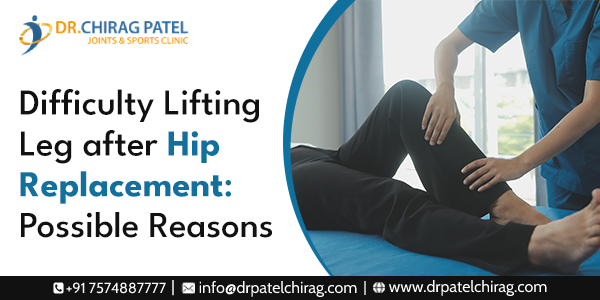Severe and complex hip problems can profoundly diminish the quality of an individual’s life by limiting mobility, comfort, and overall well-being. In cases where all conservative treatments fail to provide sufficient relief, hip replacement emerges as a transformative solution that gives a new lease of life to the hip by restoring mobility and reducing everyday pain.
Being a major surgery, hip replacement also demands a lengthy recovery period, which can again vary based on specific cases. Depending on the age, pre-existing health conditions, and the extent of damage, the patient’s healing process may vary. In some cases, it may take considerable time to lift the leg after hip replacement surgery for various reasons, says the best orthopaedic surgeon specialist in Mumbai, Dr. Chirag Patel.
But why do few cases suffer difficulty lifting the leg after hip replacement surgery? How can they overcome the challenges and improve their recovery process? With insights from a leading hip replacement surgeon in Mumbai, Dr. Chirag Patel, let us explore this topic in this blog.
Difficulty Lifting Leg after Hip Replacement: Possible Reasons
Muscle Weakness: In some cases, the surgical procedure may weaken the muscles around the hip and its support structure. The period of limited activity following the surgery can further weaken muscles, making it difficult to lift the leg post-surgery.
Postoperative Pain: Despite its relief, hip replacement can be painful after the anaesthesia wears off. Pain and discomfort can limit the range of motion, making it challenging to lift the leg. An effective rehab and recovery phase is crucial for alleviating pain and discomfort after the surgery.
Scar Tissue Formation: Surgery may trigger the development of scar tissue, which can restrict the movement of the hip joint, causing pain and discomfort significant enough to hinder leg lifting.
Joint Stiffness: Postoperative pain, limited mobility, and muscular weakness can stiffen the joints, making it challenging to support leg movement.
Improper Rehabilitation Exercises: Rehab exercises must be carefully designed based on the activity level and mobility of the patients. Adhering to a one-size-fits-all rehab program may not only cause leg pain after hip replacement surgery but also extend recovery timelines.
Nerve Impingement: Surgery may cause nerve impingement in rare cases, leading to weakness and difficulty lifting the leg. Promptly consulting an orthopaedic surgeon is essential to address any nerve-related issues.
Postoperative Swelling and Inflammation: Swelling and inflammation around the hip joint can occur after surgery, leading to mobility problems.
Hip Implant Issues: In rare cases, hip implants may cause problems due to mal-positioning or instability, triggering leg mobility issues.
But it is important to remember that difficulties in lifting leg is common after hip replacement and is not a serious problem for one to panic. An expert hip replacement surgeon anticipates these potential challenges and creates a tailored postoperative plan and recovery program to help patients avoid leg mobility problems and fast-track recovery. For more information on hip replacement surgery, you can contact the orthopaedic surgeon and leading hip specialist in Mumbai, Dr. Chirag Patel





